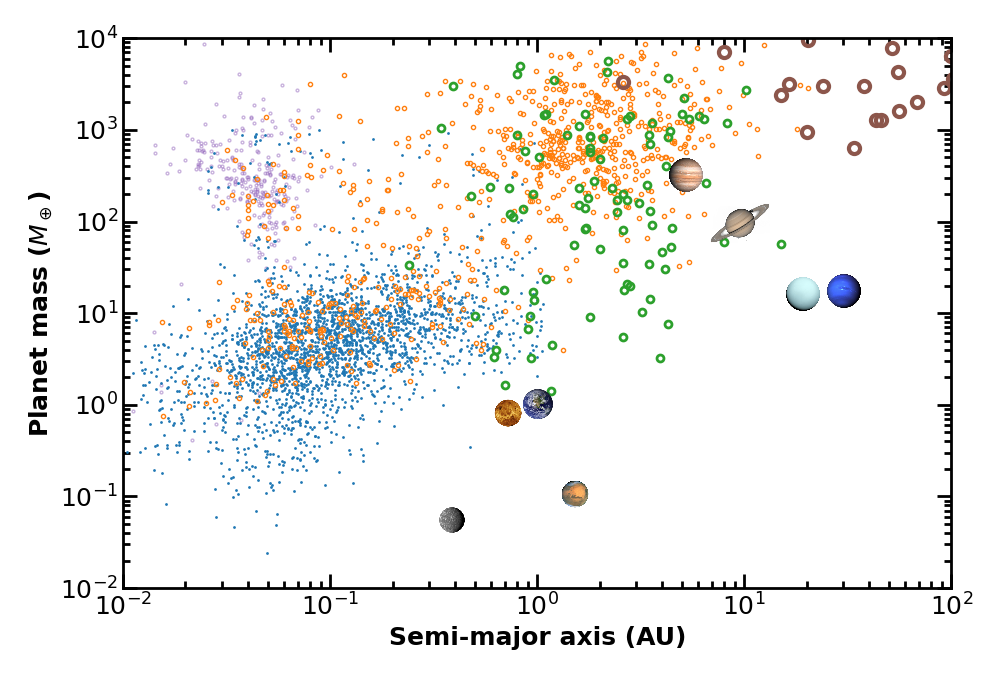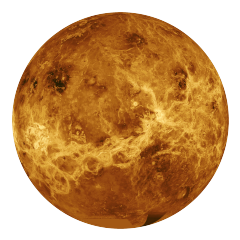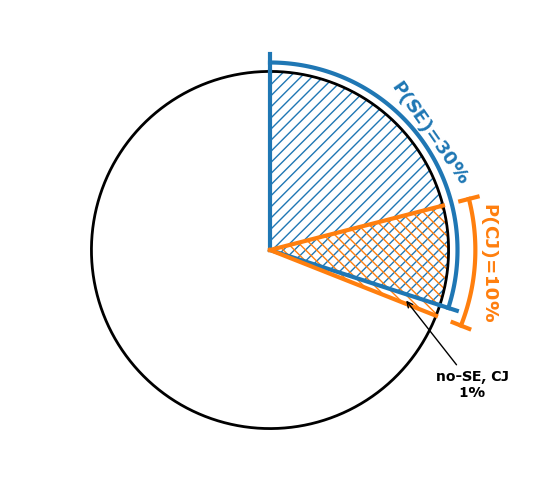Exoplanet Statistics and Implications to the ET Mission
Wei Zhu (祝伟)
ET Science Meeting
2021-4-28
Zhu & Dong 2021, ARAA in press (arXiv:2103.02127)


Transit (ground)
Transit (space)
RV
Microlensing
Imaging
Based on data from NASA Exoplanet Archive.
Hot Jupiters
Cold Jupiters
Super Earths
Cold Neptunes
Sub-Earths
What You See Is Not What You Get!
Transit (ground)
Transit (space)
RV
Microlensing
Imaging
Based on data from NASA Exoplanet Archive.
Hot Jupiters
Cold Jupiters
Super Earths
Cold Neptunes
Sub-Earths
What You See Is Not What You Get!

The ET mission can complete the exoplanet census

Earth 2.0 Microlensing
Outline
- Inner (\(\lesssim1\) AU) system statistics
- Outer (~1-10 AU) system statistics
- Summary & discussion
发生率(Occurrence Rates)
- 行星的发生率(Occurrence rate of planets)
- 行星系统的发生率(Occurrence rate of planetary systems)
- 行星系统的多重性(Multiplicity)
行星发生率(Occurrence rate of planets)

- 平均每颗恒星拥有\(1.23\pm0.06\)颗行星(\(P<400\) d, \(1-20\,R_\oplus\))
- 热木星(~1%),热海王星(~0.6%),超短周期行星(USPs, 0.5%)
- 亚地球(sub-Earths),宜居带行星(HZ planets)
宜居带行星(HZ planets)

- Different studies gave different results: ~1%-1
- Sample selection, HZ definition, statistical method, etc.
Figure from Hsu et al. (2019)
Bryson et al (2021)
HZ planet occurrence rate
Petigura et al. (2013) as an example


亚地球(Sub-Earths)

Figure from Qian & Wu (2021)
Qian & Wu (2021)
- Different studies gave different results
- Due to limited sample size, sample selection, statistical method, etc
- Questions that ET can answer:
- How many sub-Earths are there?
- How many sub-Earths reside in known systems?

- Fraction of Sun-like stars with Kepler-like planets is ~30% (Zhu et al. 2018).
- Fraction of Sun-like stars with planets in an extended parameter space may be higher (e.g., Mulders et al. 2018, He et al. 2020).


(Colors mean different observed multiplicities.)
行星系统的发生率(Occurrence rate of planetary systems)




Planet-planet mutual inclinations affect the frequency of planetary systems
Coplanarity \(\longrightarrow\)>50% of Sun-like stars have Kepler-like planets (e.g., Fressin et al. 2013, Petigura et al. 2013).







mutual inclination

Planet-planet mutual inclinations affect the frequency of planetary systems
- Fewer-planet systems are dynamically hotter.
- Each system has on average 3 planets (average multiplicity).
- Kepler observed 1.5.
- Dynamical evolution may have reshaped the architecture.
Zhu et al., 2018
(see also Xie et al. 2016, He et al. 2020)
内行星系统的本征构型
(Intrinsic architecture of the inner planetary system)
\( \sigma_i,~\sigma_e \propto k^\zeta \)


- No strong preference for mean-motion resonances (e.g., Lissauer et al. 2011, Fabrycky et al. 2014).
- Spacing depends on multiplicity.
- ~80-90% of Kepler planet pairs do not allow intermediate planets (e.g., Fang & Margot 2013).
- Kepler systems are dynamically packed (e.g., Pu & Wu 2015). However, interior/exterior planets remain allowed.
Spacing in mutual Hill radii
Implications to ET
- ET with higher sensitivity can discover new planets in known Kepler planetary systems.
- ET revisiting the Kepler field after ~15 yr will see secular motions of known planets.
恒星性质的影响
(Impact of stellar properties)
-
Dilution effect due to background star
- 10% (30%) of Kepler planet hosts have companions within 1" (4"), the majority of which are faint (e.g., Ciardi et al. 2015, Furlan et al. 2017).
-
Bound stellar companions
- Close-in stellar companion suppresses planet occurrences.
- Stellar metallicity & mass dependences.
- ET field & target selections.

Figure from Moe & Kratter (2019)
Moe & Kratter (2019)
外行星系统
(Outer planetary system)

Cold Jupiters
Cold Neptunes
- ~10% Sun-like stars have cold Jupiters (e.g., Cumming et al. 2008), and more have smaller/lower-mass planets.
- ~6% for Jupiter analogs (Wittenmyer+2016).
- Many Kepler long period planets show TTVs (Wang et al. 2016).
Microlensing mass ratio break?

Figure from Suzuki et al. (2016)
- Early results suggested a turn-over in the microlensing mass ratio function (Suzuki et al. 2016).
- With more low-mass detections from KMTNet (mostly by WC Zang) this break is (likely) no longer necessary.
- ET microlensing should detect many more low-mass-ratio microlensing planets.
ET potential in microlensing parallax



CSST
KMTNet
Earth 2.0
Roman
Kepler
Spitzer
Image credit: NASA/JPL

0.01 AU (\(2\,R_\odot\))
Earth 2.0 Telescope
CSST (lens@7kpc)
CSST (lens@4kpc)
Planet-to-star mass ratio=\(10^{-5}\)
- ET+ground-based telescopes (or CSST) can measure masses of FFPs and bound planets (Gould, Zang et al. 2020).
Cold Jupiters
Super Earths

22 from Kepler (triangles) + 39 from RV (squares)
-
1/3 of Kepler systems have cold Jupiter companions.
- >50%, if [Fe/H]>0.
Inner-outer correlation
- Cold Jupiters (almost) always have inner super Earth companions!
\( P({\rm SE}|{\rm CJ}) \cdot P({\rm CJ}) = P({\rm CJ}|{\rm SE}) \cdot P({\rm SE}) \)
\( \rightarrow P({\rm SE}|{\rm CJ})=100\% \)
(Un)Popularity of Solar system-like architecture
- Solar system has no super Earth (70%); Solar system has a cold Jupiter (10%).
- A pathway to find Earth-like planet in Solar system-like planetary system?

Summary
- Planets are abundant in our Galaxy, and many (most?) of them reside in multi-planet systems.
- Kepler Mission was great but unsuccessful in determining \(\eta_\oplus\).
- A revisit of the Kepler field can tell us more about the intrinsic architecture:
- Secular dynamics, discovering new (and smaller) planets.
- Cold planets are common (tens of %) and preferentially have inner companions.
- ET transit & microlensing can complete the exoplanet census!